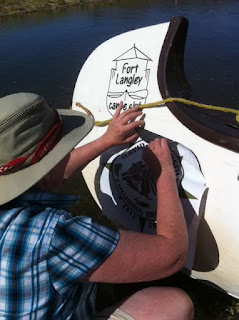Come to the Premiere of the film Tracing the Columbia-- Saturday, November 19, 2011, in Abbotsford, BC.
It’s going to be a fun weekend. Arrive on Friday so you can paddle with us, and more.
Saturday is the BIG day
Day trip (3 hours) on the Fraser River, from Mission to Fort Langley, starts early (9am) in the morning (Pre-registration is required; lunch makings will be available)
Tour Western Canoeing & Kayaking - where CLIPPER canoes are made.
Guided tours will be available at 4:10 and 4:30.
Their large retail store will remain open late for those who would like to do some shopping; 1717 Salton Rd., Abbotsford, B.C.
(No host) Supper at Finnigan’s Pub & Grill,
33780 King Road, Abbotsford
Tracing the Columbia (the film premiere) is at 7 pm at the University of the Fraser Valley
33844 King Road.
With Reception afterwards
If you pre-ordered your copy, it will be available for pick-up.
Western Canoeing, Finnigan’s Pub and the University are all within easy walking distance of each other.
If you fly into Abbotsford (WestJet) , there is a very affordable shuttle service into Abbotsford. Rental cars are available too.
Accommodations
We have reserved a block of rooms at Best Western Bakerview Inn, 1821 Sumas Way, Abbotsford, BC V2S 4L5. Call them directly to book, 1-877-336-6156, or email bwbakerviewinn@shawcable.com. Tell them you are with the David Thompson Columbia Brigade to get the price $84 plus taxes. All rooms have a fridge & microwave. There’s a restaurant connected to the hotel—and many other choices for food and drink within walking distance. See http://www.roomstays.com/hotel/523555 for more details. You must book by November 1!
Please reserve your tickets for the film by emailing Katie Stein Sather, ksather@shaw.ca. Tickets are complimentary for Brigade members, $10 for others. They will also be available for purchase at the door.
Space on the Fraser River day trip, in voyageur canoes and a Pacific Dancer (The Dancer is a First Nations canoe, built by Clipper and patterned after those used on the south coast of BC) is limited. Please reserve your spot, and know that we will probably have the boats full. Please email Katie, ksather@shaw.ca. The cost will be $20 for non-members of the Fort Langley Canoe Club, $10 for members.
Please remember that November is BC’s rainy season; come prepared to be wet.








